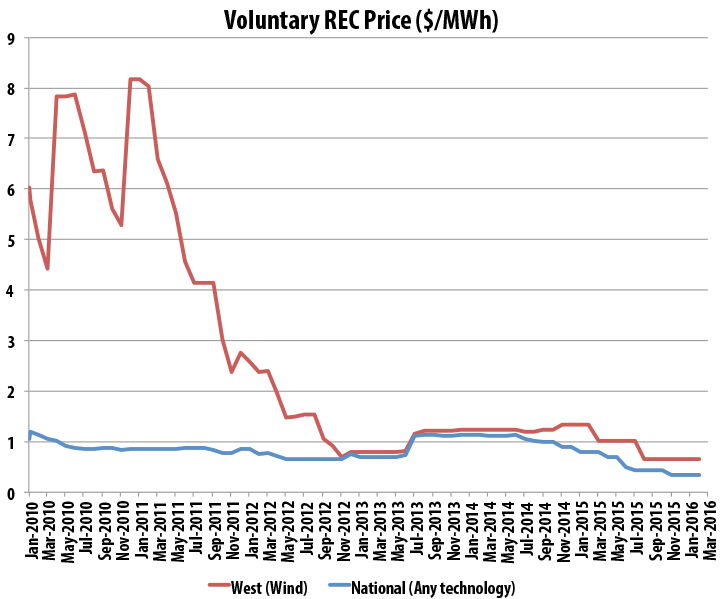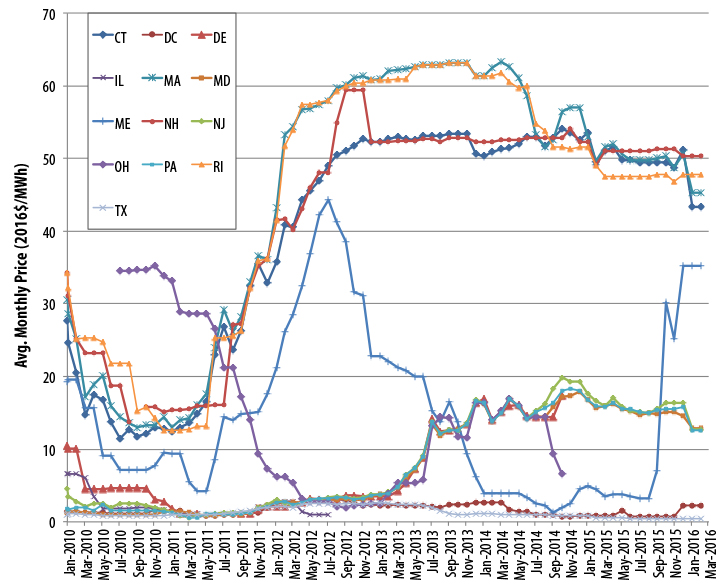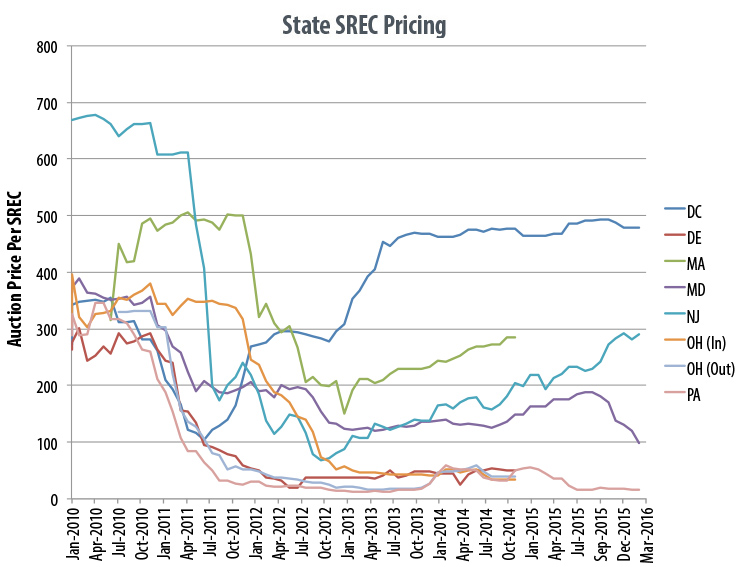 |
REC Prices
In general, REC prices depend on a number of factors, including the technology, the vintage (year in which it was generated), the volume purchased, the region in which the generator is located, whether they are eligible for certification, and whether the RECs are bought to meet compliance obligations or serve voluntary retail consumers. Natural gas prices can also affect the cost competitiveness of renewable energy generation, which is reflected in REC prices.
REC prices, in both the voluntary and compliance markets, can be difficult to determine without the assistance of a broker, and even then, available information only indicates the transactions made by one broker. A few sources offer publicly available data on SREC pricing. PJM-GATS, the state of New Jersey, and brokers at SRECTrade and Flett Exchange, all provide various forms of SREC pricing publicly. In addition to these sources, a few jurisdictions (Maryland, Pennsylvania, and District of Columbia) require that REC prices be disclosed.
Voluntary Markets for RECs
While compliance RECs generally must be sourced from within some geographic region to be eligible for RPS compliance, voluntary RECs can be sourced either regionally or nationally. Most utility green pricing programs or marketers selling bundled electricity and REC products source their products from local or regional resources, with some exceptions. Buyers of nationally sourced voluntary RECs are often large corporations that have facilities in multiple locations across the country. In voluntary markets, RECs from certain regions may sell at a premium if they are competing with RECs used for RPS demand, or are coming from regions with limited renewable resources. For example, from 2007 to December of 2011, western wind RECs sold at higher prices than nationally sourced wind RECs. Nationally sourced voluntary RECs are typically derived from the most cost-effective renewable resources nationally.
 National Voluntary REC prices and western wind REC price, January 2010 to March 2016
Source: Marex Spectron
National Voluntary REC prices and western wind REC price, January 2010 to March 2016
Source: Marex Spectron (2016). Plotted values are the last trade (if available) or the mid-point of Bid and Offer prices, for the current or nearest future compliance year traded in each month. In March 2016, nationally-sourced RECs were approximately $0.34/MWh.
Compliance Markets for RECs
The region from which RECs are sourced is particularly important because often there are regional differences in renewable energy resource quality (e.g., wind speed) and electricity prices that determine the cost-effectiveness of the renewable generation. In addition, the supply and demand of RECs often varies regionally.
 Trading Month, January 2010 to March 2016
Source: Marex Spectron
Trading Month, January 2010 to March 2016
Source: Marex Spectron (2016). Plotted values are the last trade (if available) or the mid-point of Bid and Offer prices, for the current or nearest future compliance year traded in each month.
Solar RECs (SRECs) typically transact at higher prices than RECs from other resource types in both compliance and voluntary markets. This is true for a number of reasons:
- 16 states and D.C. have specific provisions to encourage solar or customer-sited generation (www.dsireusa.org);
- the penalty price for non-compliance is often set higher for solar/distributed generation tiers than for standard RPS compliance;
- the above market cost for solar is generally higher than for other utility-scale renewable energy sources being used to meet RPS requirements and;
- SRECs can be desirable in the voluntary market where customers may be willing to pay more for solar.
Spot market SREC pricing information is available from Flett Exchange and
SRECTrade.
Weighted average prices in PJM-GATS are available through PJM-EIS.
 Compliance market SREC weighted average price, January 2010 to March 2016
Source: Marex Spectron
Compliance market SREC weighted average price, January 2010 to March 2016
Source: Marex Spectron (2016)
|

